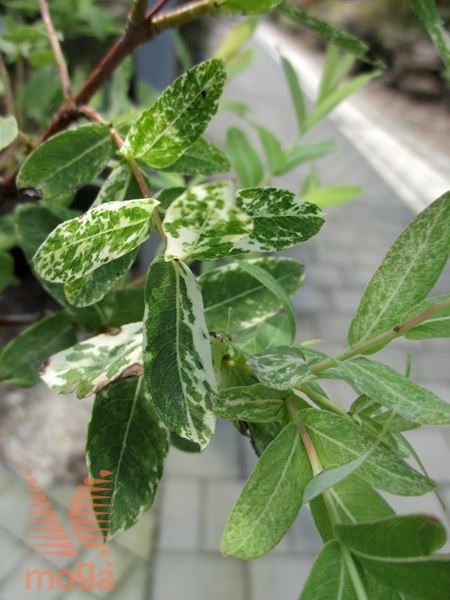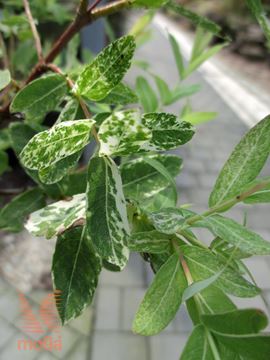Še nimate naše MOGA KARTICE UGODNOSTI
- Registracija
- Prijava
- >Primerjava izdelkov
- Seznam želja (0)
-
 Izbira jezika
Izbira jezika
- Blagajna 0
Vaša samokolnica je prazna
Blagajna
0
Salix integra "Hakuro-nishiki"
Latinski izrazi:
Salix integra "Albo-maculata"
Slovenski izrazi:
vrba "Hakuro-nishiki"
vrba "Albo-maculata"
Salix integra "Hakuro-nishiki" znano tudi kot vrba "Hakuro-nishiki" je Pritlikavo, počasi rastoče drevo ali grm (V 1,3-1,7 m, odvisno tudi od višine cepljenja, Š 1-1,5 m). Krošnja kroglasta, široka, svetla. Veje pokončne do razprte. Lubje mladih poganjkov rdeče-rjavo do zeleno-rjavo. Listi široko suličasti (4-6 cm), gladki, mladi pisani, svetlo roza z belimi in zelenimi lisami, pozneje beli z zelenimi lisami do povsem zeleni. Cvetovi v socvetjih, mačicah (2-3 cm), sivo-beli do rumeni. Cvetenje: marec-april. Semena številna, zelo drobna, s sivo-belimi dlačicami. Zorenje: maj. Uporabno tudi kot posodovka.
- Te rastline najbolje uspevajo na sončnih do delno senčnih legah. Običajno prenesejo več sonca in vročine, če imajo na voljo dovolj vlage; v delni ali rahli senci so njihove potrebe po vlagi navadno manjše.
- Listavci imajo olesenela stebla (torej debla in veje), imenujemo jih tudi lesnate rastline ali drevnina. Listi so večinoma široki, mehki in tanki.
-
Rastlina vsako pomlad razvije nove liste ali iglice, ki jeseni odpadejo. Pri zelnatih rastlinah lahko jeseni propade celoten nadzemni del (listi in stebla) in ponovno zraste spomladi.
- Rastlina ob primernih drugih rastnih pogojih prenese mraz do -23 °C.
- Propustna ali suha tla so lahka in rahla, vsaj delno peščena, v njih voda ne zastaja, temveč relativno hitro odteče v globlje plasti; takšna tla so bolj zračna in toplejša, a tudi bolj suha in navadno manj humozna, na takšnih rastiščih se pogosto pojavlja suša (npr. skalnjaki, suhozidi, ob poteh, na izrazito sončnih pobočjih, na prodnatih tleh, tudi na gramozni podlagi v naseljih in blizu zgradb...), rastline takšnih rastišč potrebujejo dobro odcedna tla, brez težav prenesejo sušo, ne prenašajo pa stalne mokrote ali celo poplavljenosti.
- Lesnata rastlina, navadno z izrazitim deblom in krošnjo. Drevo je lahko tudi večdebelno. Krošnja je različno oblikovana, redka ali gosta, simetrična ali neenakomerno oblikovana. Večina dreves doseže višino več kot 3 m.
- Pisani listi imajo vzorce različnih barv, največkrat je vzorec bel ali rumen na zeleni podlagi. Vzorec so lahko črte, lise, pike, obrobe, lahko tudi neenakomerni vzorci ali razpršena barva; različni odtenki lahko postopno prehajajo ali pa so med ploskvami različnih barv ostre meje. Intenzivnost barv in vzorci listov ali iglic na posamezni rastlini variirajo glede na splošno zdravje in stanje rastline, njeno starost, način obrezovanja in oskrbe, močno pa lahko vplivajo tudi vreme, mikroklima, osončenost, tla ter dostopnost vode in hranil. Obarvanost in vzorci na listih se lahko spreminjajo glede na starost posameznega lista ali poganjka in skozi letne čase.
Nakup izdelka

MOGA d.o.o.
Družba za urejanje okolja
Zemljičeva ulica 21
2000 Maribor
Slovenija
Sedež podjetja in storitvene dejavnosti
+386 (0)2 4716310
[email protected]
Vrtni center
+386 (0)2 4716313
[email protected]

























